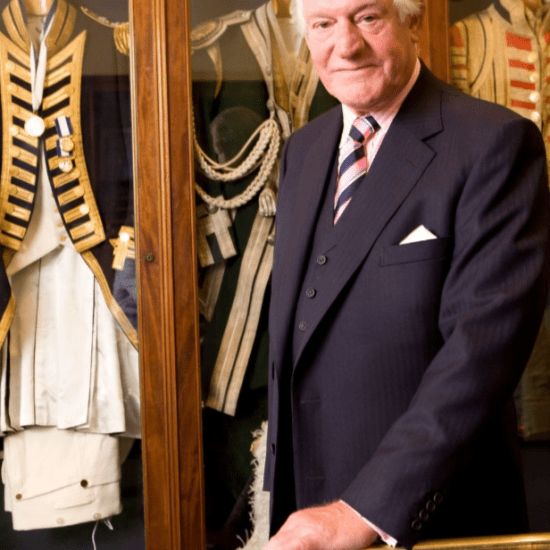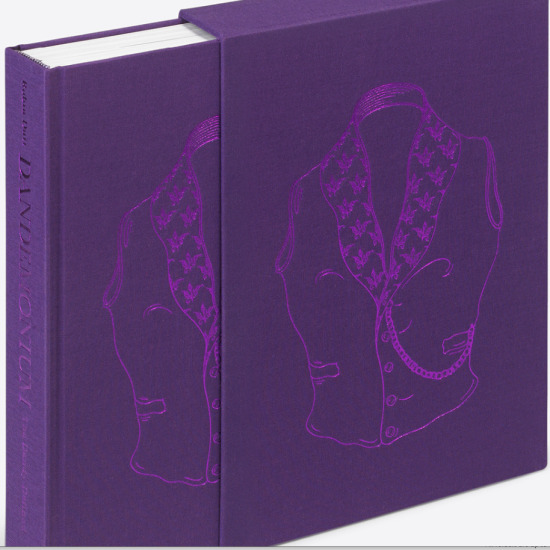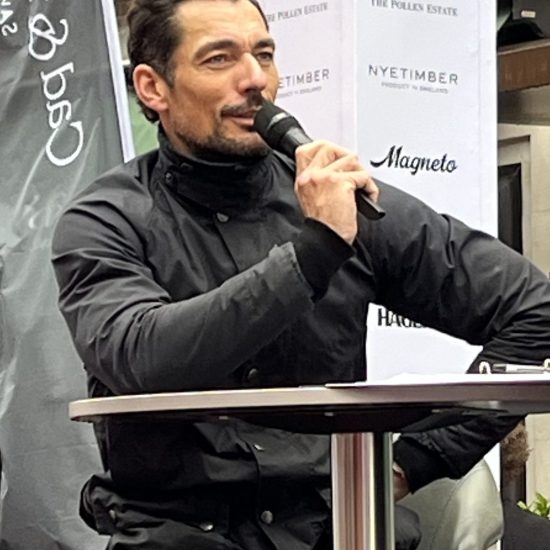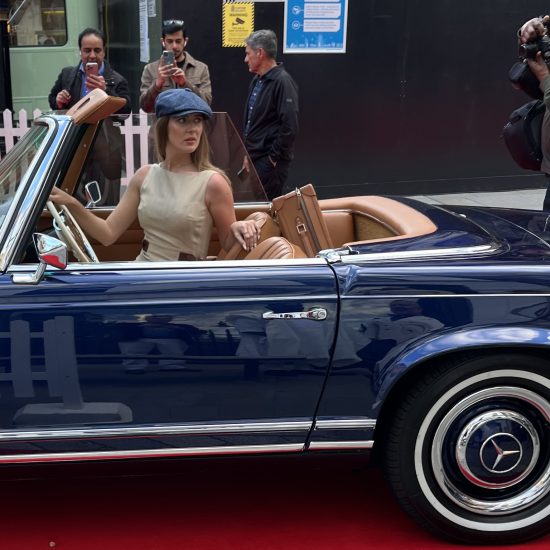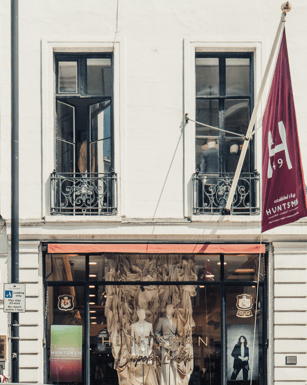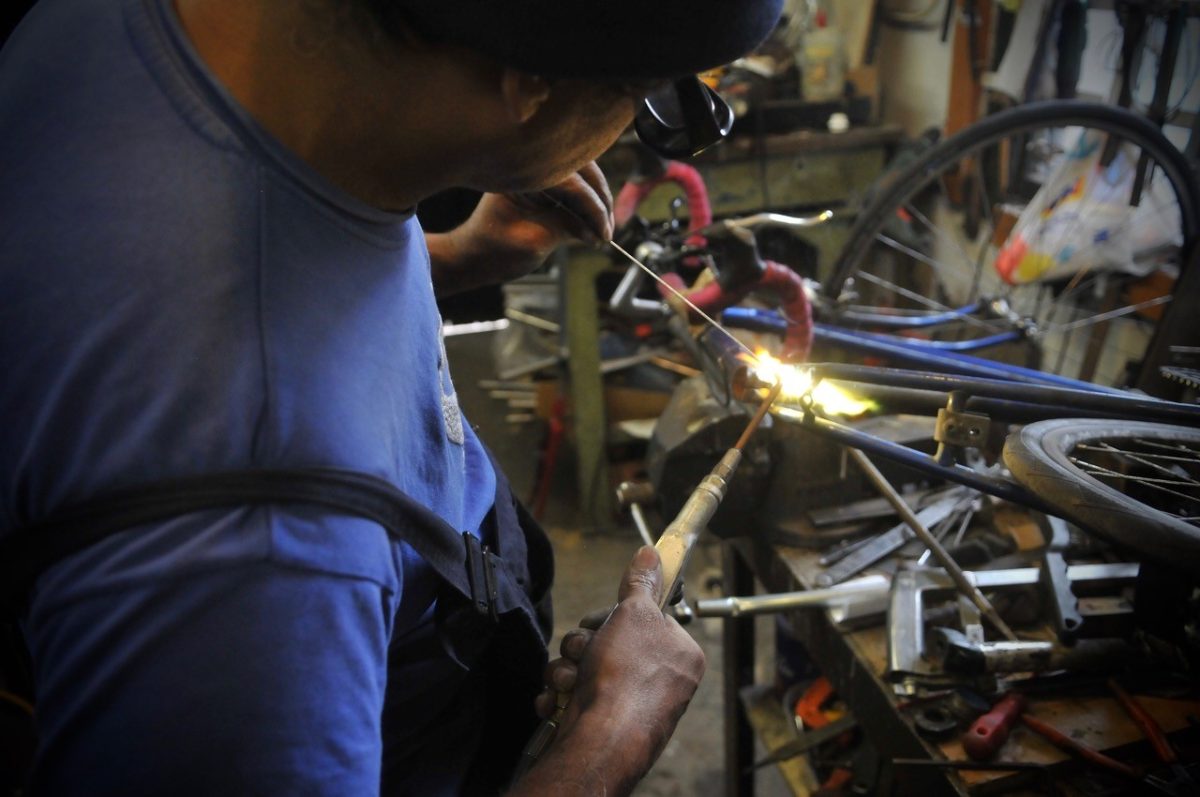
David Ward, below, a well-established Savile Row tailor, on why getting a custom-made bike is very similar to ordering a bespoke suit
 Once upon a time, the process for acquiring a high-end road bike would be to approach your nearby custom frame builder and have something made by hand. It’s an occupation now seldom seen on most UK high streets and the demise of this once true citadel of British craftsmanship has been run out of town by an evolution in consumer habits that have changed greatly. We now live in an age where the accessibility to purchase anything we want, at any time we want, is merely dependent on the strength of an internet connection and a hand within reach of a computer or smart phone.
Once upon a time, the process for acquiring a high-end road bike would be to approach your nearby custom frame builder and have something made by hand. It’s an occupation now seldom seen on most UK high streets and the demise of this once true citadel of British craftsmanship has been run out of town by an evolution in consumer habits that have changed greatly. We now live in an age where the accessibility to purchase anything we want, at any time we want, is merely dependent on the strength of an internet connection and a hand within reach of a computer or smart phone.
The age-old trope of “popping to the shops” has become a long-forgotten phrase and an abandoned practice for many. This technology has granted cyclists retail liberation and it’s never been easier to purchase a new complete bike or frame, from a variety of manufacturers anywhere in the world. With the rapid development of e-commerce backed by a huge array of companies willing to quench the appetite of any consumer, the delivery of a new carbon frame to your front door is now effortless.
Although still largely made in China (but embarrassingly sold as ‘designed somewhere else’), this new competition has made cycling more affordable. Also, the quality of bikes has improved dramatically during the past decade and the specification of their accompanying group sets has followed this trend. But with this advancement to make cycling more economical and accessible, this has sadly induced the collapse of the British custom frame building industry, once noted as a paragon of craftsmanship throughout the world. We now see fewer and fewer local bike shops providing a service where you can have a bicycle made by hand as well as picking one up off the shelf.
British frame builders of the mid 20th century were part of a golden era of craftsmanship. It was a time of exceptional artistry, only rivalled by Italian frame builders. Frame builders such as Jack Denny of London, Harry Quinn of Liverpool and Hilton Wrigley from Yorkshire, were men who could apparently size anyone up for a bike just by looking at them. So where did all the bike builders go? Many as we would expect, like the names already mentioned, have sadly left this life, but if you are in the know, there are still a few of these savants amongst us, still upholding the beauty of this wonderful craft; you’ve just got to know where to look!
Prior to my first cycling tour across America, my bike needed a bit of tweaking to become a tourer and was missing rear bosses (threaded holes) at the top of the seat stays to accommodate a rack for my panniers. My local bike store mentioned that I should give Winston Vaz in Hither Green in south London a call. “He used to be the custom frame builder for Holdsworth and Roberts,” two names that I knew had pedigree status in British frame building history. I called him and introduced myself and my problem, and a friendly voice told me to pop along to his workshop and he’d take a look.
Sometimes in life, if we’re very lucky, we might chance upon an old curiosity shop filled with the contents of a particular vice we might obsess over. But this description could not illuminate what I was to discover inside a dusty old warehouse that had clearly seen better days, settled amongst the residential back streets of Hither Green, just off London’s busy south circular. Complete with a broken window that had been patched up with a piece of plywood and adorned with mysterious exterior relics that at some point in its history had had a use, stood an old, weather worn building, looking quite bleak and dog eared. I knocked on one of the large heavy doors that guarded its contents and shuffled inside.
Amongst an array of debris and tools that were unrecognisable to me, I was eventually able to focus my eyesight in the darkness and my surroundings. The workshop space was a little messy, cluttered, and chaotic. The interior walls that were starved of natural daylight suddenly came into focus and I could now see that they were garnished with an array of beautiful old steel bicycle frames that would have any cycling enthusiast salivating with the slightest glance in their direction. The names Roberts, Holdsworth, Hetchins, Pinerello, Colnago, Peugeot and Basso lit up the shadows. Standing amongst the disorder with a disarming smile was Winston Vaz and he welcomed me with a warm and friendly “Hi Dave”.
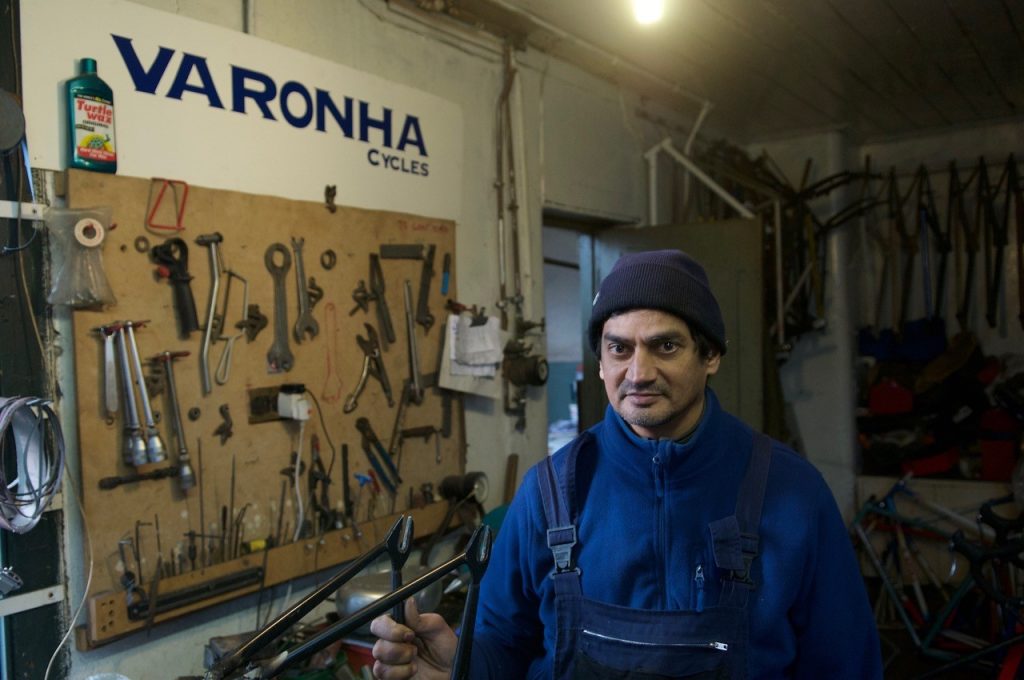 Leaving school at 16, Winston Vaz found an apprenticeship at Holdsworth, which was then situated in Anerley in South London as a frame filer. At the time, his brother Mario was the foreman of the Holdsworth spray shop, which had helped Winston’s transition into full time employment. A frame filer’s job was to smooth out and clean up newly made custom frames, a necessity to learn before moving on to more technical aspects of the work such as brazing bridges and lugs. After nine years of repetitive toil to amass a skills set to become confident in all aspects of constructing a frame from scratch, Holdsworth was sold to a rival company and Winston was out of a job. Fortunately, his unemployment coincided at a time when Roberts cycles, under the helm of legendary Chas Roberts, were looking for another frame builder to join its ranks, and Winston was recommended for the position. He had been used to the higher volumes of bicycles being made at the Holdsworth factory, but the process for frame building at Roberts became more of an individual pursuit. At Roberts, a frame builder would work on single client custom order, which afforded Winston the time to fine-tune all of the skills he had learned at Holdsworth. His work had now become a secluded activity and he was now constructing individual frames for the gourmet end of the industry.
Leaving school at 16, Winston Vaz found an apprenticeship at Holdsworth, which was then situated in Anerley in South London as a frame filer. At the time, his brother Mario was the foreman of the Holdsworth spray shop, which had helped Winston’s transition into full time employment. A frame filer’s job was to smooth out and clean up newly made custom frames, a necessity to learn before moving on to more technical aspects of the work such as brazing bridges and lugs. After nine years of repetitive toil to amass a skills set to become confident in all aspects of constructing a frame from scratch, Holdsworth was sold to a rival company and Winston was out of a job. Fortunately, his unemployment coincided at a time when Roberts cycles, under the helm of legendary Chas Roberts, were looking for another frame builder to join its ranks, and Winston was recommended for the position. He had been used to the higher volumes of bicycles being made at the Holdsworth factory, but the process for frame building at Roberts became more of an individual pursuit. At Roberts, a frame builder would work on single client custom order, which afforded Winston the time to fine-tune all of the skills he had learned at Holdsworth. His work had now become a secluded activity and he was now constructing individual frames for the gourmet end of the industry.
At Holdsworth, he had become the company trouble-shooter and could rectify any problem in the frame building process due to his proficiency in all areas of the job, and at Roberts, this wealth of knowledge was being sharpened. During his time at Roberts, Winston ended up being one of only two custom frame builders in the company, eventually becoming in his own right, very much part of the rich reputational heritage of frame builders in the UK. When I asked him if he still enjoyed the process of making bikes after all these years, his response couldn’t have been more enthusiastic in its delivery. “I still love it,” he explained, “I still get a kick out of being able to create something that I feel is unrivalled in quality and having my stamp positioned upon a finished frame, it really is something special”. Winston can still recognise the Roberts and Holdsworth frames that he built all those years ago as he crafted very minor subtleties into the frames that gave his work a recognisable distinction and signature.
In spite of the abilities to understand the nuances of the human anatomy when it is wrapped around pieces of steel in the form of a bicycle, the standard procedure to measure someone for a hand-built frame hasn’t changed much over the years. It is still a reliable practice to take individual body measurements from a customer, and then build those measurements into the frames construction. An inside leg measure, torso, forearm, femur, shoulder width, shoe size, height and weight are all noted and then used to create a one-off bicycle for the individual out of high-quality steel tubing. Steel was and still is the material of choice for a custom frame. Like the development of bicycles, steel has also seen advances in its construction over the years, and now new alloys offer weights that are much closer to that of aluminium, yet unlike aluminium, it is more stable over time and suffers less from fatigue and is incredibly durable.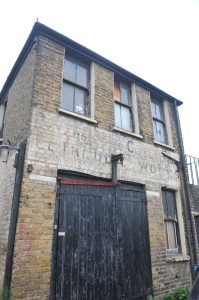
Having a bike made by hand is a process and not a straightforward transaction like picking up something off the shelf or online. It is labour intensive craftsmanship and might well take two months to complete a frame from start to finish, with the necessary fittings to achieve that Goldilocks moment. Time scales are irrelevant while every idiosyncrasy of the individual’s proportions are considered and expertly built into your new order. Like a pair of bespoke shoes or the enshrined pedigree of Savile Row suit, the synergies with custom frame building couldn’t be more similar. It’s a pure indulgence of passion for the cyclist to attain that illusive hand in glove feeling in the form of brazed steel and Winston Vaz is an elder statesman in this vocation.
In spite of the demise of this once incredible industry, cyclists in the know, who appreciate quality, preciseness and the beauty of having something made by hand, are still knocking on the big black doors of Winston’s workshop. The enduring reputation of Roberts frames amongst the UK’s cycling fraternity, still holds an awful lot of sway and Winston Vaz was their master frame builder for 28 years, up until the company closed in 2014. A couple of years before Roberts cycles closed down, he had decided to join his brother Mario and go it alone, making hand built frames under his own name from the workshop in Herne Hill. He chose the name Varohna for his company, that combined the two surnames of his Goan parents: Vaz and Narohna.
“I still get a select few clients coming through the door who still have a reverence for lightweight steel, road and touring frames made by hand, there will always be a market for things made by hand and made well”. His clients include cyclists who have graduated their cycling experience and progressively bought better quality frames, to people with deeper pockets who will order a hand made frame from Reynolds 953 stainless steel. Winston regularly ships his frames internationally to clients who seek him out. This incredibly modest man is renowned, globally. His brother Mario, who is also one of the most respected frame sprayers in the country, is still part of the process and his spray shop is sprawled out on the top floor of the building and is an extension of the beauty that is downstairs.
On my tour of the US, whilst sitting in a particularly deserted diner in small town called Craigmont in the depths of Idaho, an elderly gentleman approached me after hearing my accent and seeing my bike parked outside and introduced himself. He then proudly informed that he had recently purchased an old custom Holdsworth frame. “I’ve always just loved British steel bicycle manufacturing because of its renowned quality and heritage” he explained. When I told him I lived near where the Holdsworth factory had been in south London, he couldn’t believe what he was hearing. When I told him I knew the person whose hands had probably built his new pride and joy, he stared at me open mouthed for what seemed like a minute.
British bike buildings appeal and legacy, still has a far-reaching audience. We can only hope that people with the skills and pedigree of Winston Vaz are still plying their wonderful skills in years to come and sharing that knowledge. It would truly be a shame for this fine land to become void of individuals like Winston and the artistry for which he is famed for. He is truly an artisan with few to rival his abilities and expertise. But what would be most unfortunate, is if I was the last person to share such a beautiful story and make the day of an elderly gentleman, in a rundown restaurant, in a far-flung corner of north west America who had a deep affection and love for all things made incredibly well in the United Kingdom.



